PR-6170RUK Science A STEM Approach - Primary 1
Create successful ePaper yourself
Turn your PDF publications into a flip-book with our unique Google optimized e-Paper software.
Materials<br />
MATERIALS HAVE <strong>PR</strong>OPERTIES<br />
Lesson 1<br />
Lesson Plan<br />
Introduction:<br />
1. Play a sorting game with the class. Have all pupils sit on the mat and silently select a category, such<br />
as hair colour. Allocate a position in the classroom for each hair colour without the pupils knowing.<br />
Silently, tap individual pupils on the shoulder and point to the allocated position or say a pupil's<br />
name in that group to instruct them where to move to. When all pupils have been allocated a<br />
position, they quietly discuss why they think they have been placed together.<br />
2. Discuss that humans often sort objects into groups that have something in common. How else<br />
could we sort everyone into groups? Encourage pupils to think about size, clothing worn, gender<br />
and eye colour.<br />
Development:<br />
3. Divide the class into groups of between four and six pupils, and in the middle of each group place<br />
an assortment of pre-prepared objects from each type of material listed on page 76.<br />
Each group's objects should be the same and should contain a variety of different-sized and<br />
different-coloured objects. Ask pupils Can you sort these objects by colour? How many groups did<br />
you make? How would you label each group? Check each group's answers as they work and clarify<br />
any objects that are in the wrong group. Take a digital photograph of each group with their sorted<br />
objects.<br />
4. Using the same objects, complete the same activity but ask pupils to sort objects according to size.<br />
Repeat the questions and take a photograph of each group with their sorted objects. Discuss that<br />
sometimes we group objects by their appearance, such as their colour, size or shape, but we can<br />
also use our other senses to group items in different ways.<br />
5. Using the same objects, ask pupils to use their five senses to sort the objects into the materials they<br />
think each object is made from. Ask pupils How many groups did you make? How would you label<br />
each group? Depending on pupils' answers, ask them to try to sort the items into eight different<br />
groups of materials. Take a digital photograph of each group with their sorted objects.<br />
6. Give each group a pre-prepared set of the eight buckets on page 77. Assist pupils to read the<br />
words on each label, looking for beginning, middle and end sounds. This will help them to read the<br />
words independently during the activity. Ask pupils Can you match these buckets to your groups?<br />
Do any objects need to change groups? Pupils move any incorrect objects to where they think they<br />
should be placed. Take another digital photograph of each group with their sorted objects.<br />
Differentiation<br />
• Less able pupils may be told the labels to each sorting activity and asked to sort the objects into<br />
those groups; for example, can you sort these objects into small, medium and large objects?<br />
Can you group all the metal objects together?<br />
• More able pupils should be encouraged to name, write or draw other objects that are made<br />
from each material.<br />
Viewing sample<br />
7. As a class, ask one group to share the objects they had in one group of materials. Take turns<br />
to allow all groups to share. Discuss the correct answers and encourage pupils to check their<br />
groupings and make any adjustments necessary.<br />
Reflection:<br />
8. Using a think-pair-share, think of a material and ask pupils to name an object that is made from that<br />
material; for example, Can you think of an object that is made from metal? Each pair must choose<br />
two different objects to share with the class.<br />
www.prim-ed.com – Prim-Ed Publishing 978-1-912760-14-5 Infants<br />
<strong>Science</strong>:<br />
A <strong>STEM</strong> AP<strong>PR</strong>OACH<br />
75


















